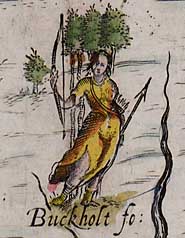|

Michael Drayton's allegorical representation of Buckholt Forest,
Hampshire, in Poly-Olbion
How Many Forests
Survived?
The
Case for Further Research
Seeing the
Wood for the Trees
The
Project Team
Work Achieved
Work in Progress
Contact Us
Back
to Home Page
|
Aims and Objectives
The purpose of the project is to raise
awareness of, excite interest in, and win funding for systematic, comprehensive, multi-disciplinary investigation
of the Forests and Chases of England and Wales: in particular their spatial, temporal, functional, and cultural
origins, significance, and survival.
Here are some of the more important topics addressed by the project team and
other scholars involved in this area.
Social
and economic
 The
emergence of forests and their relationship to pre-Conquest 'common pool
resources' The
emergence of forests and their relationship to pre-Conquest 'common pool
resources'
 Allied
with this, the processes and results of afforestation and disafforestation Allied
with this, the processes and results of afforestation and disafforestation
 Aristocratic
patronage and perquisites, and their relationship to royal and aristocratic
hunting Aristocratic
patronage and perquisites, and their relationship to royal and aristocratic
hunting
 Livelihood
for the marginalised (as exemplified in squatting, poor's woods and commons) Livelihood
for the marginalised (as exemplified in squatting, poor's woods and commons)
 Swanimote
and other courts (among the oldest forms of local self-determination,
crucial to Swanimote
and other courts (among the oldest forms of local self-determination,
crucial to
recovering pre-modern communitas)
 Forests
as expressions of kingship and theatres of power Forests
as expressions of kingship and theatres of power
 Cultural
diversity, including religion (particularly early-modern Recusancy and
medieval imagery) Cultural
diversity, including religion (particularly early-modern Recusancy and
medieval imagery)
 Demography,
including squatting, and economic linkages Demography,
including squatting, and economic linkages
 Poaching,
protest
and riot, including resistance to afforestation and later to the game laws Poaching,
protest
and riot, including resistance to afforestation and later to the game laws
Ecological
and environmental
 Changes
in habits of 'hunting and gathering' as a major element of pre-industrial
agrarian and Changes
in habits of 'hunting and gathering' as a major element of pre-industrial
agrarian and
domestic regimes
 The
march of medieval assarting and post-medieval enclosure The
march of medieval assarting and post-medieval enclosure
 The
origins and uses of vaccaries The
origins and uses of vaccaries
 Fuel
demands, particularly as impacting on forest commons Fuel
demands, particularly as impacting on forest commons
 The
spread of country house parkland as social expression and landscape
component The
spread of country house parkland as social expression and landscape
component
 The
onset of 'scientific' forestry and state management The
onset of 'scientific' forestry and state management
 Transitional
hunting landscapes (alongside developments in horse-breeding, -trading, and Transitional
hunting landscapes (alongside developments in horse-breeding, -trading, and
-racing, and military theory and practice)
Scholarly and public policy
 Human
ecotypes as a model of discourse and analysis Human
ecotypes as a model of discourse and analysis
 Modernity
and alternative frameworks for describing the survival of forest societies
and Modernity
and alternative frameworks for describing the survival of forest societies
and
economy
 Cartography,
including its use as a tool of state governance Cartography,
including its use as a tool of state governance
 Landscape
evaluation; and Countryside access and management Landscape
evaluation; and Countryside access and management
 and
their relevance to conservation, sustainability, and renewable resources. and
their relevance to conservation, sustainability, and renewable resources.
Data exists in documents, maps and plans,
literature, and fieldwork, and the results of results will continue to be disseminated to
scholars and the wider public electronically as well as in print and through
workshops, papers, and lectures.
The partial state of knowledge about
forests and chases is typified by the need to ask
'How many forests survived into and through early modern times?'
(For an
introductory discussion, click on the title in the side panel.) A summary of
the perceived significance of the research, written for a general
readership, is also accessible from the panel: 'The case for further
research', together with 'Seeing the wood for the trees', an article in the
St John's College journal, TW.

|
